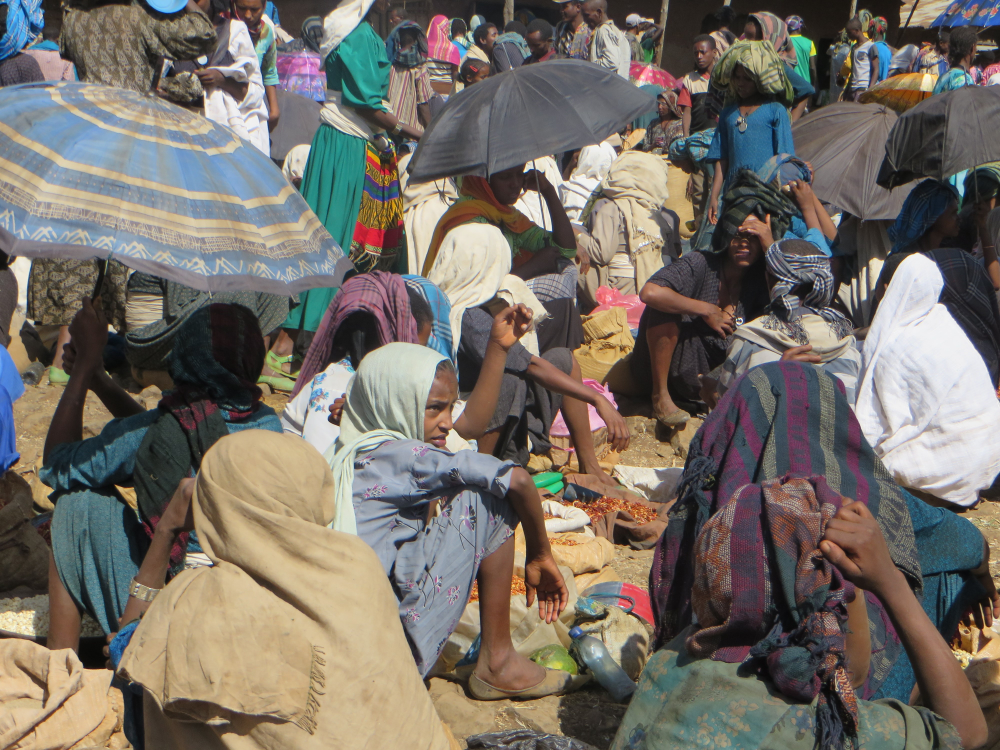Access to nutritious food plays a key role in reaching the United Nation’s Sustainable Development Goal of ending all forms of malnutrition by 2030. As most people reside in rural areas, access to food in low-income countries is typically organized through self-sufficiency in food production. But households rarely live in isolation: most households engage in market transactions by selling part of their own production in an exchange for other food or non-food items. The frequency of such transactions is likely to depend on the household’s distance to such markets.
IFPRI’s Ethiopia Strategy Support Program has conducted a series of research on the linkages between market access and child nutrition. Ethiopia is a particularly interesting country in which to study this. Despite considerable improvements over the past decade, chronic child under-nutrition and low dietary diversity remain widespread in Ethiopia. As one of the largest countries in Africa – both in terms of population and land area – Ethiopia has extremely diverse agro-climatic conditions that permit the cultivation of an enormous variety of foods across the country. However, as a result of rugged terrain and poor – though improving – infrastructure, access to food varies widely. A common sight in the rural areas of the country is men and women carrying heavy food sacks to a market, either by themselves or using pack animals. Sometimes such travels can take several hours if not days.
A persistent result emerging from this research is that proximity to food markets is associated with better, more diverse diets – and, in some instances, with lower child under-nutrition rates. In 2011 and 2015, our survey teams collected novel household data that covered a relatively small area in the Amhara region but with large variation in transportation costs. Research using these data found that households in more remote areas consumed substantially less than households nearer to markets, and their diets were also less diverse. However, there were no significant differences in anthropometric measures between less and more remotely located children. Similarly, analysis of high-frequency panel data from one district in the Tigray region in north Ethiopia showed that children located closer to food markets consumed more diverse diets than children residing in more remote areas. Also, in contrast to the null findings from the Amhara region, children’s nutritional status in the Tigray region was significantly better near food markets (even after controlling for wealth and education levels in the household).
Another line of research within this theme focuses on the linkages between agricultural production and pre-school children’s diets. In developed countries, food markets are typically sufficiently integrated so that farmers can focus on producing foods in which they have a comparative advantage (for example, because of climate, soil quality or altitude). But in the rural areas of many low-income countries, such separability between consumption and production decisions may not hold. If households are located far away from market, own food production will largely determine what foods are available for consumption. This is exactly what was found in a study of milk markets and children’s milk consumption in Ethiopia. This work was extended by considering a wider variety of food products and similar results were found. Interestingly, access to food also matters for the efficiency of nutrition sensitive programs. Data from this remote area in the Amhara region was also used to study the effect of increasing caregivers’ nutrition knowledge on children’s dietary diversity. A striking result arising from this work is that while nutrition knowledge leads to considerable improvements in children’s diets, it has no impact in the most remote localities.
Access to food does not only vary across space, but also within the calendar year due to the seasonal nature of agricultural production. A recent ESSP study found that households’ energy intakes and dietary diversity fluctuate considerably between the post-harvest and lean season in Ethiopia. Encouraged by the findings in the earlier work, we wanted to test whether access to food markets would also mitigate the impacts of seasonality on child under-nutrition. Using longitudinal survey data from the Tigray region, children were generally found to be better nourished near food markets, but their (age or height adjusted) weights were subject to considerable seasonal fluctuations. The magnitudes of these seasonal weight fluctuations were similar to the ones observed in children located in more remote areas.
In light of these research findings, in order to improve diets in Ethiopia, policy makers have to ensure that caregivers have both access to nutritious foods and also the knowledge required to demand such foods. Lack of knowledge of good feeding practices and of the importance of dietary diversity remain widespread in Ethiopia (see here and here). Evidence from Ethiopia and elsewhere shows that Behavioral Change Communication (BCC) is an effective tool to tackle such knowledge constraints (see here, here and here). But as our research shows, the effectiveness of BCC requires access to food. In the long run, access to food should ideally be mediated through food markets. In the short run, more remote households may have to be self-sufficient in producing the foods they want to consume. But this may not be possible in all areas as agro-climatic conditions impose constraints on farmers’ production choices. Moreover, there are efficiency gains from specialization and encouraging households to diversify their food production undermines these gains. Finally, improving market access is not sufficient to solve the seasonal nature of agricultural production leading to fluctuations in food availability and food prices. Addressing this issue requires different approaches, such as investments in better storage technologies and expansion of irrigated areas. Cross-regional trade within Ethiopia (as well as international trade) could also play a role as seasonal weather patterns and other acro-climatic conditions vary across the country.
Note: mesob is a round handwoven basket-like table in which Ethiopian meal is traditionally served.







